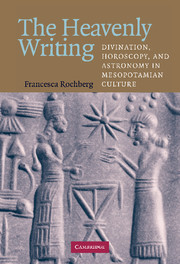Book contents
- Frontmatter
- Contents
- Preface
- Acknowledgments
- Abbreviations
- Chronological References and Akkadian and Astronomical Terminology
- The Heavenly Writing
- Prologue
- 1 The Historiography of Mesopotamian Science
- 2 Celestial Divination in Context
- 3 Personal Celestial Divination: The Babylonian Horoscopes
- 4 Sources for Horoscopes in Astronomical Texts
- 5 Sources for Horoscopes in the Early Astrological Tradition
- 6 The Scribes and Scholars of Mesopotamian Celestial Science
- 7 The Classification of Mesopotamian Celestial Inquiry as Science
- Epilogue
- Bibliography
- Name Index
- Subject Index
1 - The Historiography of Mesopotamian Science
Published online by Cambridge University Press: 08 January 2010
- Frontmatter
- Contents
- Preface
- Acknowledgments
- Abbreviations
- Chronological References and Akkadian and Astronomical Terminology
- The Heavenly Writing
- Prologue
- 1 The Historiography of Mesopotamian Science
- 2 Celestial Divination in Context
- 3 Personal Celestial Divination: The Babylonian Horoscopes
- 4 Sources for Horoscopes in Astronomical Texts
- 5 Sources for Horoscopes in the Early Astrological Tradition
- 6 The Scribes and Scholars of Mesopotamian Celestial Science
- 7 The Classification of Mesopotamian Celestial Inquiry as Science
- Epilogue
- Bibliography
- Name Index
- Subject Index
Summary
If science has a universal aspect underlying any and all its manifestations in human culture, then a reappraisal of the nature of scientific inquiry should pertain in some measure to modern and to Babylonian science alike. And even if no universal essence is to be found among the various attempts to understand the phenomena of nature, then certainly no cogent argument against inclusion of the attempts evidenced in cuneiform texts can be given as we would certainly want to know the extent of science's diversity. If our conception of science is necessarily grounded in evidence of both its results and its practice, then history has an important role to play, as was suggested in the opening statement of Thomas Kuhn's The Structure of Scientific Revolutions when he said, “History, if viewed as a repository for more than anecdote or chronology, could produce a decisive transformation in the image of science by which we are now possessed.”
The rediscovery of the earliest evidence for the cultural and intellectual practice we term science is a relatively recent achievement in the history of scholarship. From the first readings of cuneiform astronomical texts in the late nineteenth century by J. Epping and J. N. Strassmaier to the publication of Astronomical Cuneiform Texts by O. Neugebauer in 1955 and the Astronomical Diaries by A. J. Sachs and H. Hunger from 1988 to 2001, it is clear that the process of decipherment and analysis of Babylonian astronomy has taken place over a span of time during which the idea of science itself has undergone significant changes.
- Type
- Chapter
- Information
- The Heavenly WritingDivination, Horoscopy, and Astronomy in Mesopotamian Culture, pp. 14 - 43Publisher: Cambridge University PressPrint publication year: 2004



